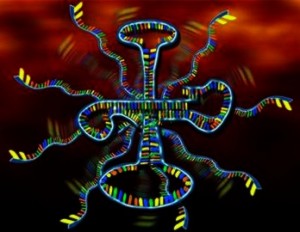THE RNA WORLD: CHAPTER 1
The RNA World: Third Edition. Raymond F. Gesteland, Thomas R. Cech and John F. Atkins eds., Cold Spring Harbor Laboratory Press, Cold Spring Harbor New York 2006. ISBN: 0-87969-739-3
In the beginning was the nucleoside, and the nucleoside was of the tribe of base and the tribe of pentose. And it was null and void, and then "let there be phosphate" was said in the beginning.
It is almost orthodoxy that prior to modern life whose genetic information is contained in DNA (deoxyribonucleic acid) there was a world in which RNA (ribonucleic acid) was the basis of life, both in terms of information storage and in terms of the catalysis that is presently done by protein enzymes. I'm presently reading a book with various aspects of this "RNA world". The subject matter is far ranging and presented by an assembly of authors. It's indicative of the progress of this field that even a book published in 2006 may be out-of-date in many things. Yet, some things still hold true, and many speculations remain just that.
Chapter 1: Setting the Stage: The History, Chemistry and Geobiology Behind RNA by Steven A. Benner, Mathew A. Carrigan Alonso Ricardo and Fabianne Frye
This introduction is a review of RNA chemistry. It also states the two basic hypotheses of the RNA world. One is the "RNA first" theory where early organic chemistry would lead directly to oligonucleoside chains that were genetically capable. The other hypothesis is the "genetic takeover" theory in which RNA only later became the repository of genetic information when it "took over" this function from a previous self-replicating system. There is good evidence, working backward from present biochemistry, that RNA was an earlier form of genetic control. The second theory is more speculative.
By also working backwards from molecular phylogeny it is also pretty well established that protein synthesis via translation was present in the early eubacteria living near 2 billion years ago. This means that the RNA world was a thing of the past by then. There is strong evidence that ALL present life descended from a last universal common ancestor (LUCA) that had well established translation system. There are, however, systems of duplicate proteins/genes which could have predated this LUCA.
"Moving forwards" from the origin of Earth gives another perspective on the beginnings of genetic control whether by RNA directly or by genetic takeover.Many alternatives to our present DNA and RNA with different bases, different systems of polymerization or different sugar backbones have been synthesized and investigated.
The authors of this chapter go into a number of possible catalytic and autocatalytic mechanisms using the concepts of nucleophilicity and electrophilicity. They begin with the synthesis of ribose from formaldehyde (presumably already present on an early Earth) via the formose reaction in which glycolaldehyde (3 carbon) is an end product. Another carbon of formaldehyde can pair with this to form a four carbon sugar as can another glycolaldehyde to form a pentose such as ribose with the production of another formaldehyde.
Both formaldehyde and glycolaldehyde are naturally present in the interstellar medium. While much of this reaction is autocatalytic there is a problem.The ribose formed such a reaction itself takes part automatically in further reactions to form a complex mixture of products known affectionately as "brown goo". This has led several proposals of ways in which ribose could be stabilized. It has also led to theories about pre-RNA alternatives such as peptide nucleic acids or non-sugar backgrounds for the primordial genetic system.
One way in which ribose may be made more stable is if the original reactants are phosphate esters of glycolaldehyde. The result is a pentose 2,4-diphosphate. An alternative mechanism is via stabilization via 'minerals'. The most quoted example is borate, B(OH)3 which forms a complex with two hydroxyl groups on ribose. Or with glyceraldehyde which can then combine with glocolaldehyde to form a pentose.
Borate salts are often soluble in water and are found in deposits from evaporate water. [Think the Borax 20 Mule Team from Death Valley Days.]. Such evaporates may be found in dry valleys such as Death Valley or in a 'playa lake' (a high pH incompletely evaporated body of water). Could Death Valley really be "Life Valley" ? Borate deposits in China from Archean time show that such systems were present in Earth's past.
One of the difficult points of this perspective of ribose synthesis is step 1, the reaction of formaldehyde to form glycolaldehyde. Once the latter is formed the reaction then becomes autocatalytic. Even though glycolaldehyde is present in space the reaction for its formation is kinetically unlikely. This, however, may not be an insurmountable problem given enough deep time.
The necessity of water throws further complications in the way of nucleic acid synthesis. First of all the bases adenine, cytosine and guanine are all unstable in water at pH 7 and 37 degrees. Similarly the sugar-base bond and the phosphate ester bonds are prone to hydrolysis in such conditions. The modern genome survives because of continued enzymatic repair. Water, on the other hand, is generally considered necessary for nucleic acid base pairing.
The authors suggest that an alternating dry-wet environment such as that of alkali lakes might be a possible place where RNA chemistry could become stable. They also mention formamide as an alternative solvent other than water. This liquid is also most likely to be found in a desert environment.
This chapter ends by stating the authors' preference for an 'RNA-first' model as most consistent with our present knowledge. This is supported both by the ribose chemistry that they review and by information of models of other possible genetic polymers.

No comments:
Post a Comment